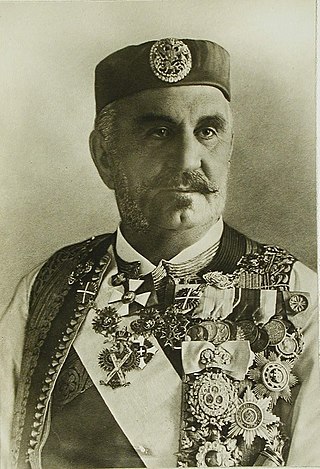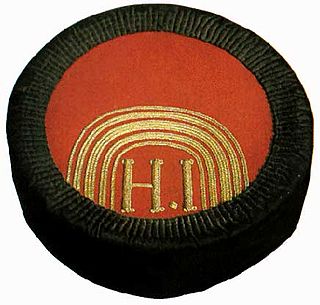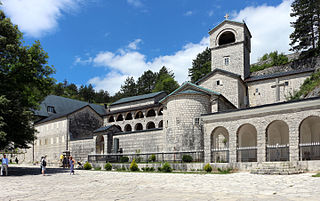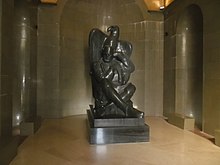The early written records of the history of Montenegro begin with Illyria and its various kingdoms until the Roman Republic incorporated the region into the province of Illyricum after the Illyro-Roman Wars.

Petar II Petrović-Njegoš, commonly referred to simply as Njegoš (Његош), was a Prince-Bishop (vladika) of Montenegro, poet and philosopher whose works are widely considered some of the most important in Montenegrin and Serbian literature.

Cetinje is a town in Montenegro. It is the former royal capital of Montenegro and is the location of several national institutions, including the official residence of the president of Montenegro. According to the 2023 census, the town had a population of 12,460 while the Cetinje Municipality had 14,465 residents. Cetinje is the centre of Cetinje Municipality. The city rests on a small karst plain surrounded by limestone mountains, including Mount Lovćen, the legendary mountain in Montenegrin historiography. Cetinje was founded in the 15th century and became a cradle of the culture of Montenegro. Its status as the honorary capital of Montenegro is due to its heritage as a long-serving former capital of Montenegro.

Petar I Petrović-Njegoš was the ruler of the Prince-Bishopric of Montenegro as the Metropolitan (vladika) of Cetinje, and Exarch (legate) of the Serbian Orthodox Church in Montenegro. He was the most popular spiritual and military leader from the Petrović dynasty. During his long rule, Petar strengthened the state by uniting the often quarreling tribes, consolidating his control over Montenegrin lands, introducing the first laws in Montenegro. His rule prepared Montenegro for the subsequent introduction of modern institutions of the state: taxes, schools and larger commercial enterprises. He was canonized by the Serbian Orthodox Church as Saint Peter of Cetinje.

Nikola I Petrović-Njegoš was the last monarch of Montenegro from 1860 to 1918, reigning as prince from 1860 to 1910 and as the country's first and only king from 1910 to 1918. His grandsons were kings Alexander I of Yugoslavia and Umberto II of Italy among others.

Princess Zorka Karađorđević, born Princess Ljubica of Montenegro, was the eldest child of Prince Nicholas I and Princess Milena of Montenegro, who later became the country's king and queen consort. In 1883, Ljubica married Prince Peter Karađorđević and she changed her name to Zorka. She died in childbirth while giving birth to Prince Andrija on 16 March 1890. Prince Andrija died shortly thereafter. Zorka's husband later became king of Serbia as Peter I.

Lovćen is a mountain and national park in southwestern Montenegro. It is the inspiration behind the names Montenegro and Crna Gora, both of which mean 'Black Mountain' and refer to the appearance of Mount Lovćen when covered in dense forests. The name Crna Gora was first mentioned in a charter issued by Stefan Milutin in 1276 and was used for several regions across medieval Serbian lands, including Skopska Crna Gora and Užička Crna Gora.

The Montenegrin cap is a cap traditionally worn in Montenegro by the Montenegrins and Serbs of Montenegro. It was introduced by Prince Bishop Petar II Petrović-Njegoš in the mid-1840s as a replacement for the then-popular fez.

Krsto Popović was an officer of the Montenegrin Army who fought in the Balkan Wars and in the First World War.

The Metropolitanate of Montenegro and the Littoral of the Serbian Orthodox Church is the largest eparchy (diocese) of the Serbian Orthodox Church in modern Montenegro. Founded in 1219 by Saint Sava as the Eparchy of Zeta, it has continued to exist, without interruption, up to the present time, and has remained one of the most prominent dioceses of the Serbian Orthodox Church. The current Metropolitan bishop is Joanikije II. His official title is "Metropolitan of Montenegro and the Littoral".

Lovćenac is a village located in the Mali Iđoš municipality, in the North Bačka District of Vojvodina, Serbia. The village is known as the de facto capital of Montenegrins in Serbia, and has a total population of 3,161 people.

The culture of Montenegro is as pluralistic and diverse as its history and geographical position would suggest. Montenegro's culture has been influenced by the Serbian Empire, the Byzantine Empire, ancient Greece, ancient Rome, Christianity, the Ottoman Empire, the Republic of Venice, Austria-Hungary, and Yugoslavia.

Stadium Sveti Petar Cetinjski is a football-specific stadium constructed in 2022 in Cetinje, Montenegro. It is the same site on which there was a historic venue called Stadion Obilića Poljana which opened in 1957 and was used until 2017. Upon its completion, the new stadium will be used by Cetinje's local football teams as well as the Montenegro national football team. It was named after Petar I Petrović-Njegoš.

Milena Petrović-Njegoš was the only queen consort of Montenegro by marriage to Nicholas I of Montenegro.

The Cetinje Monastery is a monastery of the Serbian Orthodox Church in Montenegro. It is located in Cetinje and is the seat of the Metropolitanate of Montenegro. A center of historical and cultural importance, it was founded c. 1484 by Prince Ivan Crnojević of Zeta, and designated as the cathedral monastery of the Eparchy of Zeta. It was devastated in 1692, during the Morean War, and rebuilt between 1701 and 1704 by Metropolitan Danilo Petrović-Njegoš on the site of the former court of Ivan Crnojević.

The Prince-Bishopric of Montenegro was a Serbian Orthodox ecclesiastical principality that existed from 1516 until 1852. The principality was located around modern-day Montenegro. It emerged from the Eparchy of Cetinje, later known as the Metropolitanate of Montenegro and the Littoral, whose bishops defied the Ottoman Empire overlordship and transformed the parish of Cetinje into a de facto theocracy, ruling it as Metropolitans.

The Podmaine Monastery is a Serbian Orthodox monastery built in the 15th century by the Crnojević noble family in Podmaine near Budva, Zeta. The monastery has two churches, smaller and older church of Presentation of the Mother of God was built by Crnojević noble family in the 15th century while bigger church was built in 1747.
Nikanor Ivanović was Bishop of Cetinje and Metropolitan of Montenegro and the Highlands from 1858 to 1860.

The Theological Seminary of St. Peter of Cetinje is a secondary Orthodox theological school of Serbian Orthodox Church in Cetinje, Montenegro. The rector of the seminary is archpriest-staurophore Gojko Perović.

The Njegoš's Testament Church was a Serbian Orthodox church at the site of modern-day Mausoleum of Njegoš located on the top of Lovćen. It was a chapel dedicated to Saint Peter of Cetinje, built in 1845 according to the wishes of Petar II Petrović-Njegoš, with the desire to be buried there. Njegoš died on October 31, 1851, but was initially buried in the Cetinje Monastery out of fear that the Ottoman forces might desecrate his grave. His remains were later transferred to Lovćen on August 27, 1855. The Russian ethnographer Pavel Rovinsky attended a memorial service for Njegoš. The chapel was finally demolished in 1972 to make way for the construction of the Njegoš Mausoleum, completed in 1974.

























